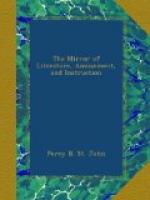What blockhead thinks now of reading Milton, or Pope, or Gray? Paradise Lost is lost; it has gone to the devil. Pope’s Epistles are returned to the dead-letter office; the age is too loyal for “ruin seize thee, ruthless king,” and the oldest inhabitant has forgotten “the curfew tolls.”—Blackwood’s Magazine.
* * * * *
THE SELECTOR, AND LITERARY NOTICES OF NEW WORKS.
* * * * *
DR. LARDNER’S CYCLOPAEDIA.
History of Scotland. By Sir Walter Scott, Bart. Vol. I.
The rapid and sketchy page just quoted from Blackwood’s Magazine will illustrate the high ground which periodical literature is daily attaining in this country. Of this ascendancy, the volume before us is indeed a fine specimen, and one of which we have reason to entertain a national pride. We know it to be a common practice with publishers on the continent to produce long works volume by volume, so that Dr. Lardner’s plan is by no means novel; but we should also bear in mind that, compared with our family and cabinet libraries, the majority of similar foreign works are mere flimsy productions; and the Encyclopedie Methodique, published in monthly volumes, in Paris, both in quantity and execution, will not reach our literary standards of 1829. As Dr. Lardner’s plan is well known, it need not here be repeated; neither need we remark upon the high qualifications of Sir Walter Scott, as an historian of Scotland. An extract shall speak for itself; and perhaps we cannot do better than select one of the battle-pieces, which has all the vividness of the finest historical painting: say
BANNOCKBURN.
“Robert Bruce summoned the array of his kingdom to rendezvous in the Tor-wood, about four miles from Stirling, and by degrees prepared the field of battle which he had selected for the contest. It was a space of ground then called the New Park—perhaps reserved for the chase, since Stirling was frequently a royal residence. This ground was partly open, partly encumbered with trees, in groups or separate. It was occupied by the Scottish line of battle, extending from south to north, and fronting to the east. In this position, Bruce’s left flank and rear might have been exposed to a sally from the castle of Stirling; but Mowbray the governor’s faith




